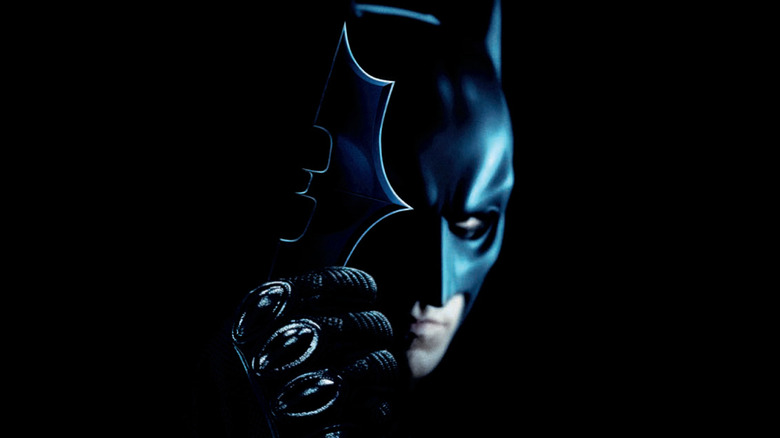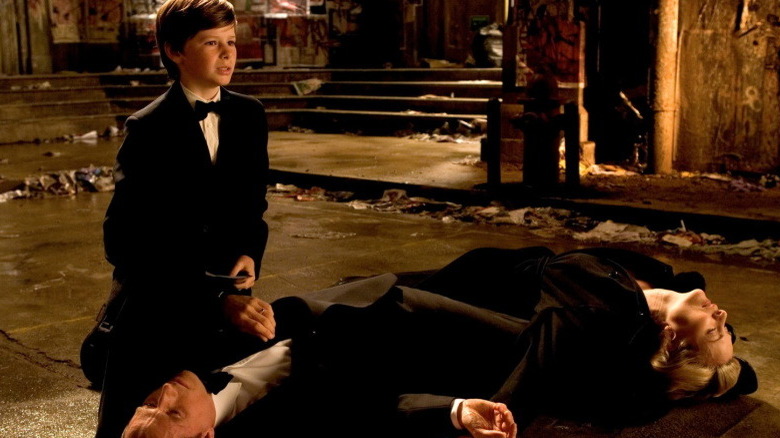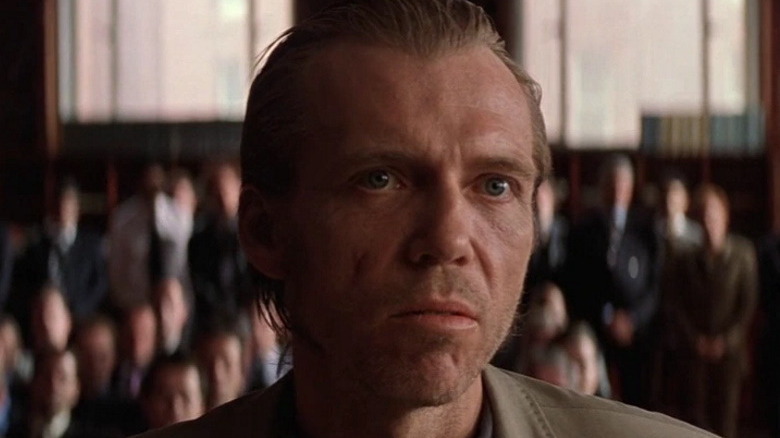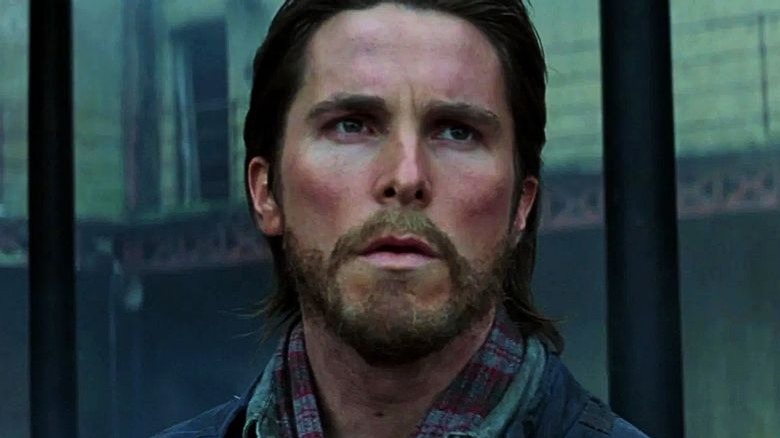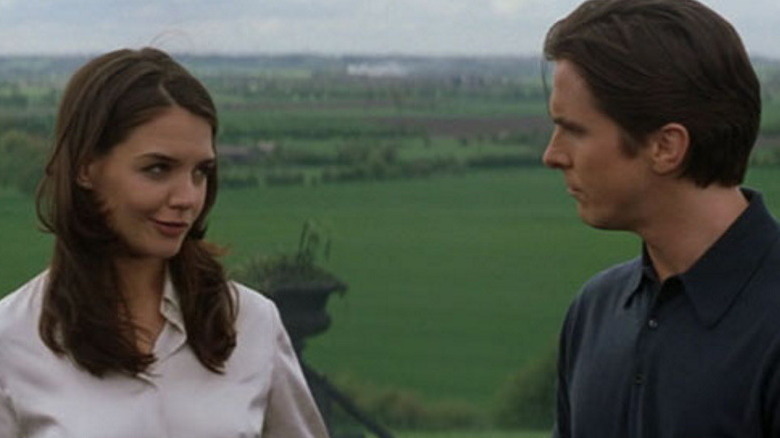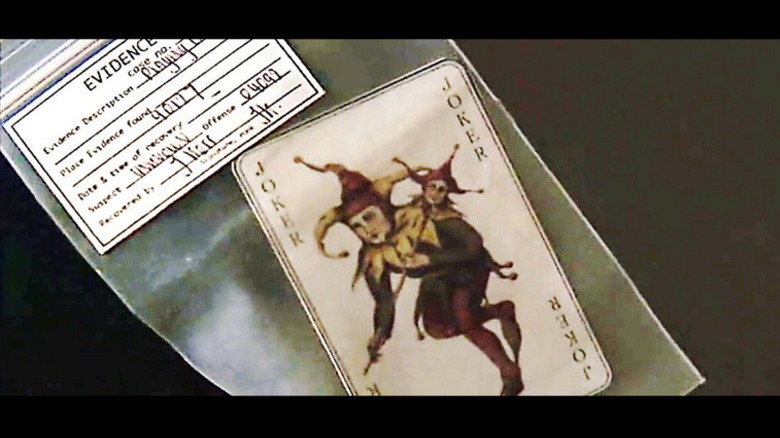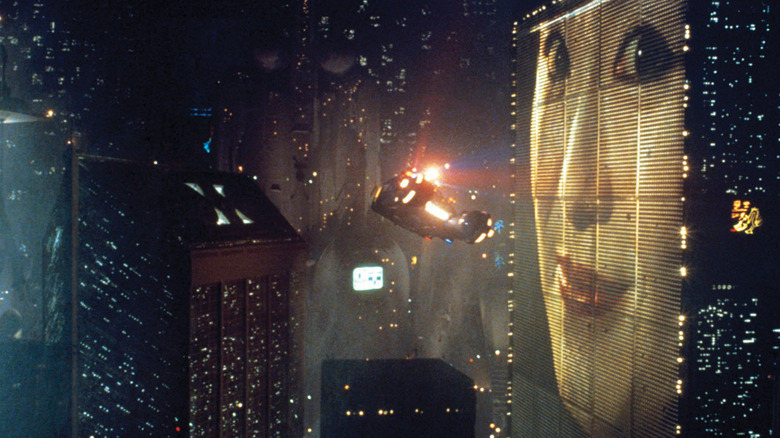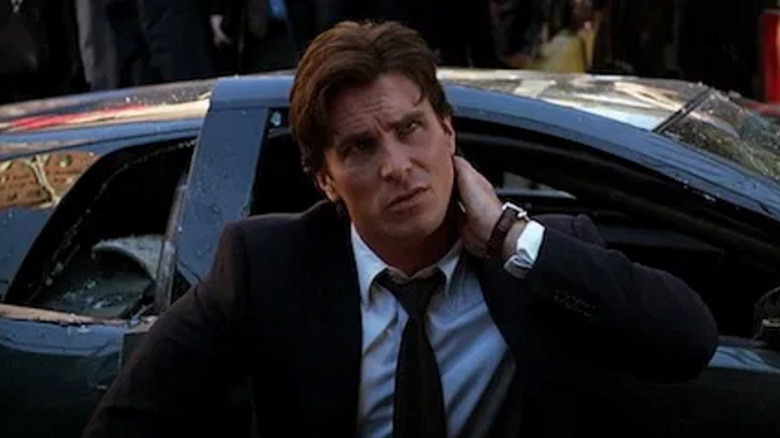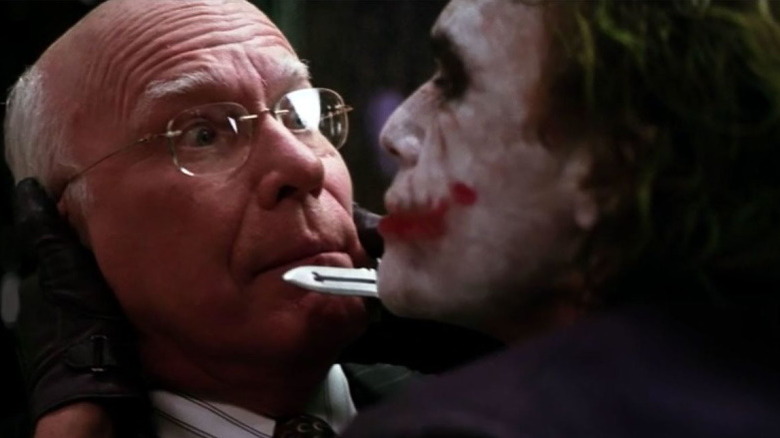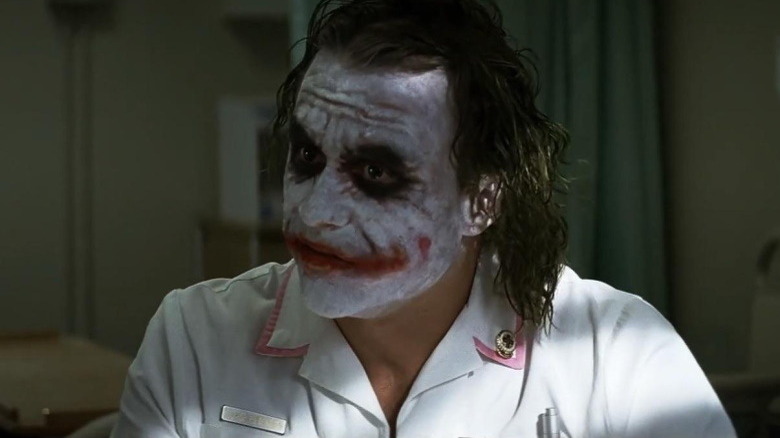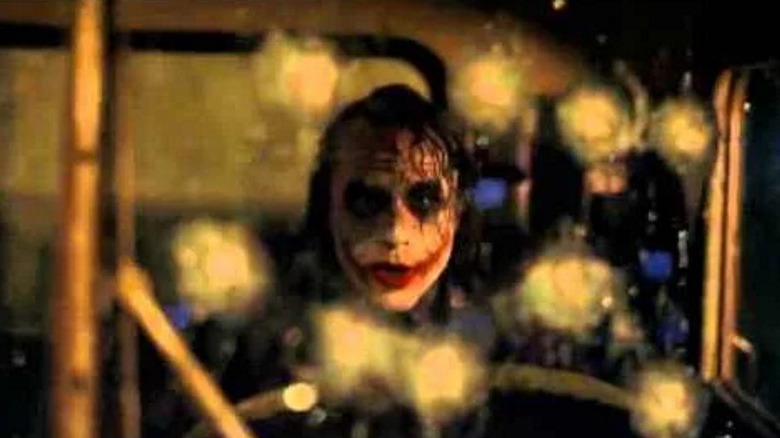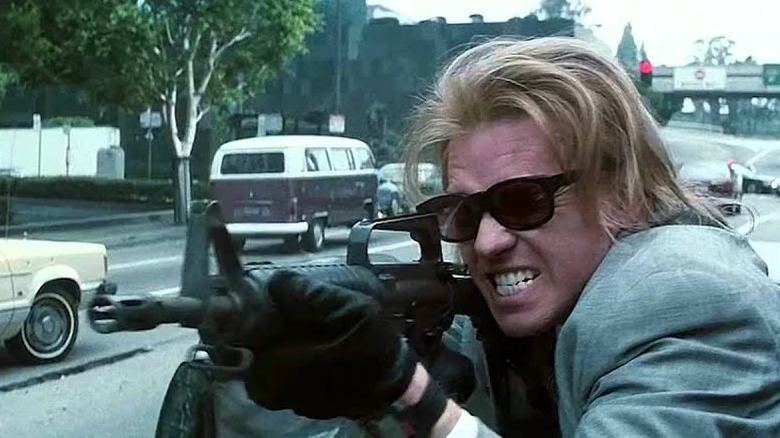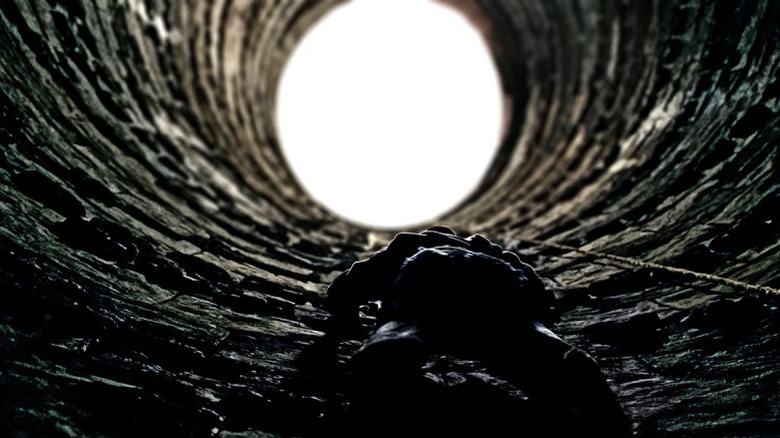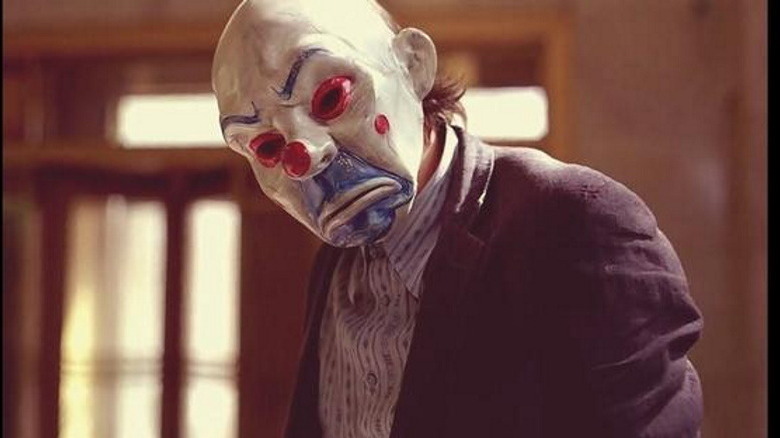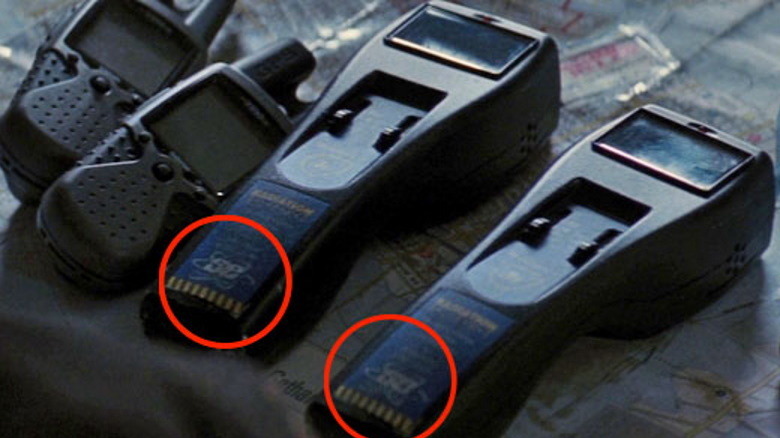Things You Probably Missed In The Dark Knight Trilogy
Christopher Nolan's "Dark Knight Trilogy" is considered a classic among superhero movies and perhaps the best Batman film series to date. The movies have won numerous awards, including a posthumous Academy Award for Best Supporting Actor to Heath Ledger for his groundbreaking portrayal of the Joker in "The Dark Knight" (2008) and a Movie of the Year Award from the American Film Institute. Even today, the movies continue to entertain and fans regularly re-watch the series again and again.
However, there are still plenty of small details that even Batman superfans may have missed in "The Dark Knight" trilogy. From subtle winks to the comic book source, to additional material found in novelizations, to surprising cameos from fans, the movies continue to provide new things to look for in subsequent viewings. Here are a few key moments you may have missed in the "Dark Knight Trilogy."
The League of Shadows is responsible for the deaths of the Waynes
"Batman Begins" (2005) is one of the first Batman movies to present a comic book-accurate depiction of the murder of Bruce Wayne's parents. Rather than attribute their deaths to a Batman villain like the Joker (as Tim Burton did in 1989's "Batman"), the movie has Thomas and Martha Wayne shot by their comic book murderer Joe Chill (Richard Brake), a common thug who claims he was motivated by the desperation caused by Gotham City's economic depression. Ironically, Thomas and Martha had been trying to help citizens like Chill through social projects, making their deaths even more tragic.
However, a key scene at the end of "Batman Begins" reveals Chill wasn't the only person responsible for the Waynes' murder. After being confronted by his old mentor Ra's al Ghul (Liam Neeson), Bruce Wayne (Christian Bale) learns Ra's' terrorist organization the League of Shadows had been trying to destroy Gotham — which it deemed too corrupt to survive — by creating the depression that turned citizens like Chill to crime. However, the League failed to consider people like Thomas and Martha Wayne who fought back against the depression until they were killed by Chill.
Even more ironically, Bruce's butler Alfred Pennyworth (Michael Caine) reveals that the Waynes' murder martyred them and motivated Gotham's wealthy to save the city. While they couldn't stem the crime and corruption, they were able to keep the city from completely falling apart, stopping the League of Shadows.
Bruce Wayne's parents were killed by a Star Wars villain
Speaking of Joe Chill — the man who started Bruce Wayne on his path to becoming Batman was also responsible for some truly heinous deeds in a galaxy far, far away.
In "Batman Begins," Chill is played by character actor Richard Brake whose resume includes several other "chilling" roles in major productions, including the inhuman Night King in "Game of Thrones" and the cannibalistic war criminal Enrikas Dortlich in "Hannibal Rising." However, fans may be most aware of Brake's brief but memorable appearance in the Season 2 episode "The Believer" in the Star Wars series "The Mandalorian."
In the episode, Brake plays Valin Hess, a general in the Imperial Army and the former commanding officer of sharpshooter Migs Mayfield (Bill Burr). When Mayfield aids the Mandalorian in infiltrating an Imperial remnant refinery where Hess is preparing a return to power, Hess spots the trespassers and invites them to share a drink with him. After Hess gloats about Operation: Cinder, a military operation where the general chose to wipe out an entire city along with thousands of his own men, Mayfield — who was one of the few survivors — furiously shoots his former superior officer.
Hess' speech about people preferring order to freedom is a chilling one that speaks volumes of Brake's acting ability. Bruce Wayne may have not gotten his chance to get revenge on Joe Chill, but other characters haven't hesitated to take their vengeance on some of Brake's characters.
Bruce Wayne's origin mirrors the Buddha
Modern day superheroes tend to mirror iconic figures from religion or classic mythology. In Richard Donner's "Superman" (1978), Clark Kent (Christopher Reeve)'s pilgrimage to the Arctic resembles Moses' journey up Mount Sinai where he communes with a heavenly image of his father Jor-El (Marlon Brando) much like Moses saw God in a burning bush.
"Batman Begins," by contrast, shows Bruce Wayne undertaking a journey similar to that taken by the founder of Buddhism, Siddhartha Gautama. Much like Buddha, who started out living a very privileged life as a prince before he began witnessing suffering and chose to experience poverty to help gain enlightenment, Bruce Wayne is a wealthy child who decides to live among low-level criminals to understanding desperation after the murder of his parents. And just as Buddha realized he had to embrace a "Middle Way" between over-indulgence and suffering, Bruce found his own personal balance between vengeance and justice by creating Batman.
The link between Bruce's journey and Buddha's is made in the novelization of "Batman Begins." Written by comic book writer Dennis O'Neill, the book includes an additional scene where a college-age Bruce hears the story of Siddhartha, seeing parallels between his loss of innocence and the Buddha's, even before he begins his seven-year journey of discovery that allows him to rise above his fears and accept his inner demons.
Rachel Dawes is a physical manifestation of Bruce Wayne's conscience
Many of the characters in "The Dark Knight" trilogy are taken directly from the comic book source material. In addition to Bruce Wayne, the films include Commissioner Gordon (Gary Oldman) and Lucius Fox (Morgan Freeman), who play an integral role in Batman's support team.
However, this is not the case with Rachel Dawes, Bruce's love interest, who's played alternately by Katie Holmes and Maggie Gyllenhaal (as well as Emma Lockhart as a child) in the films. Bruce Wayne certainly has plenty of romantic interests in the comic books, so why create an entirely new character?
As it turns out, Rachel functions very much as a physical manifestation of Bruce Wayne's conscience — something necessary for a film series that shows the progression of Bruce from a disillusioned youth into an incorruptible crimefighter. Where Bruce vowed to battle criminals immediately after his parents' murder in the comics, in the movies, he becomes jaded about the idea of justice until Rachel shocks him into realizing his father would be ashamed of his apathetic and vengeful attitude. This puts him on the path to embrace actual justice and fight crime in his own way.
Similarly, Rachel's death in "The Dark Knight" shows Bruce losing a part of himself, which is why we find him in a depressed, semi-apathetic state in "The Dark Knight Rises." Comic book heroes may be able to communicate their motivations through captions, but film heroes need a tangible partner.
The Joker playing card contains multiple comic book references
Audiences cheered at the end of "Batman Begins" when Lieutenant Gordon informed Batman of a new criminal with a "taste for the theatrical" who left Joker playing cards to mark his crimes. While brief, the appearance of the Joker's famous calling card left audiences eager for the upcoming sequel.
However, if you pause the shot where Batman flips over the Joker card, you'll see a fun reference to the Joker's comic book roots. While the playing card itself is a clear reference to Batman's most famous arch-nemesis, the name of the officer who discovered and filed it is "J. Kerr." This is a clear reference to one of the Joker's regular comic book aliases "Joseph Kerr" (or "Joe Kerr"), which he's used when he masquerades as a regular man in flesh-tone makeup. It's a quick scene, but you have to admire the production team's attention to detail.
In fact, considering the Joker later masquerades as a police officer in "The Dark Knight" and leaves hints of his future victims on the name tags of his henchmen, maybe the "Officer J. Kerr" who filed the Joker card was the Joker himself. Now that's scary.
Batman Begins is influenced by Blade Runner
"Batman Begins" drew inspiration from a number of different sources. Some of these are obvious — Nolan has gone on record as saying the film is inspired partly from "Batman: Year One," a comic book story written by Frank Miller and drawn by David Mazzucchelli. Many key scenes — including the iconic one where Batman summons an army of bats to distract a SWAT team — come directly out of the comic.
However, one additional influence on "Batman Begins" that fans may not be aware of is a very different film classic, Ridley Scott's 1982's flick "Blade Runner." Christopher Nolan acknowledged in later interviews that "Blade Runner" influenced both the set design for Gotham City and the use of handheld cameras and longer lenses. Some interviewers, including Forbes contributor Mark Hughes, have drawn comparisons between shots where Batman pulls himself onto a rooftop in the rain and the rooftop conversation between Rick Deckard (Harrison Ford) and Roy Batty (Rutger Hauer — who, oddly enough, also appears as Wayne Enterprises CEO William Earle in "Batman Begins").
While some of these links may be coincidental, it's been established that the gritty look of "Batman Begins" owes an undeniable debt to the futuristic film noir world of "Blade Runner." Especially since Nolan screened "Blade Runner" for his cinematographer Wally Pfister early in the film's development, pointing to it as an example of the look he was searching for.
Bruce Wayne drives a Batmobile in his civilian identity
Bruce Wayne takes many steps to keep his vigilante and playboy lifestyles separate, but the filmmakers can't resist making a few sly winks about his secret identity throughout the films. In the first movie, Bruce pulls up to a swanky hotel in a flashy sports car (accompanied by two European models), causing the valet to admire his ride. Bruce offhandedly comments, "You should see my other one," referring to his famous Batmobile muscle car that makes an appearance later on before it suffers critical damage in "The Dark Knight" and self-destructs.
In another scene from "The Dark Knight," however, Bruce actually does end up driving a "Batmobile" in his civilian identity. When he learns that the Joker plans to blow up a hospital, Bruce goes after him. Asked by Alfred if he'll be needing the Batpod (the motorcycle the Batmobile jettisoned before blowing up), Bruce replies that he needs something more subtle for the middle of the day.
"The Lamborghini, then," Alfred quips. "Much more subtle."
As it turns out though, Bruce's sportscar — a Lamborghini Murciélago — does contain a subtle Batman reference. Those who understand Spanish know that Murciélago means "bat," meaning Bruce Wayne was speeding through town in a type of Batmobile after his main one was destroyed.
Joker threatens a real U.S. Senator ... and a Batman super-fan
When the Joker crashes Bruce Wayne's fundraiser for Harvey Dent, one man unexpectedly stands up to the villain, telling him, "We're not intimidated by thugs." Sadly, his bravery makes him a target of the Joker, but he's almost immediately saved by both Rachel Dawes and Batman.
Sharp-eyed Batman fans may recognize the man as Democratic U.S. Senator Patrick Leahy from Vermont. Known for overseeing former President Trump's second impeachment trial in early 2021, Leahy is now third in line for the presidency under the Biden administration.
Outside politics, however, Leahy is a huge Batman fan and has cameoed in both "Batman Forever" (1995) and "Batman and Robin" (1997). He played a Wayne Enterprises board member in "The Dark Knight" and "The Dark Knight Rises" (2012) and fittingly played a senator during Superman's senate hearing in "Batman v. Superman" (2016). His voice can also be heard in an episode of "Batman: The Animated Series," where he plays a territorial governor.
Leahy donates the fees from his Batman appearances to the Kello-Hubbard Library in Vermont, where he first read Batman comics. He even used Batman to help ban the export of landmines in 1996 when he worked with DC Comics on a Batman story about the dangers of landmines, "Death of Innocence," to gain support (the measures passed 100 to 0).
The Joker named himself after Heath Ledger's daughter
Joker routinely keeps people guessing about his true identity throughout "The Dark Knight." He tells his victims multiple versions of his origin story. The police can't figure out his real name or discover anything about his background — which has led some fans, including comedian and actor Patton Oswalt, to speculate that this Joker is actually ex-military intelligence, which explains how he's so familiar with military ordinance like bazookas and can play mind games so well during interrogations.
Regardless of the truth, the Joker does name himself at one point — and it's a name very close to actor Heath Ledger's family. In the infamous hospital scene where the Joker dresses as a nurse and confronts a bedridden Harvey Dent, you can see that his name tag reads "Matilda." Matilda is the name of Heath Ledger's real-life daughter with his actress girlfriend Michelle Williams, and was only 2 years old when "The Dark Knight" was being filmed. Today, Matilda Rose Ledger is fifteen and reportedly shares many of her father's features.
A hidden smiley face shows up in an iconic Joker scene
The Joker is a big fan of marking paraphernalia with his sick sense of humor. He purchases a custom purple suit using stolen money. He has a big red "S" painted on the side of one of his vehicles so the phrase, "Laughter is the Best Medicine" now reads, "Slaughter is the Best Medicine." However, one of his weirder signs appears to have emerged completely at random.
During the chase scene in "The Dark Knight" where the Joker tries to kill Harvey Dent, the insane clown shoves a dead body out of a truck so he can drive. When we see the front of the windshield, it's riddled with bullet holes — which just happen to form the shape of a smiley face. It's an unexpected, offbeat Easter egg that goes over the heads of most people who just glimpse the scene, but it's very much there.
The Dark Knight is influenced by Heat
The Gotham City of "Batman Begins" may have been inspired by the look of Ridley Scott's "Blade Runner," but Christopher Nolan's "The Dark Knight" draws inspiration from a different source — the cinematic backdrop Michael Mann created from the city of Los Angeles for his 1996 crime-drama "Heat."
Realizing he wanted an epic story set firmly in Gotham City, Nolan screened "Heat" to all his department heads before starting production on "The Dark Knight," just to explain how a vast universe can be created within a city full of multiple characters, each on their own emotional journeys. The result was a film that offered multiple perspectives not only from Bruce Wayne and Commissioner Gordon but also cops, citizens, and prisoners.
Nolan also referenced Mann's passion for architecture in "Heat" by using IMAX cameras that could capture the full height of Gotham's tall buildings to better convey the scope and scale of the world the Joker was trying to destroy. This gave a sense of grandeur to the story.
The prison in the Dark Knight Rises is the Lazarus Pit
Nolan's "Dark Knight" films ground the Batman mythos in a real-life setting — but that doesn't mean fans can't find some strong references to fantastic elements in Batman's comic book history. For example, there is the pit Bruce Wayne is taken to after Bane (Tom Hardy) breaks his back. While ostensibly a sadistic prison that tortures prisoners with the promise of escape while offering only death, the underground jail is very similar to the magical Lazarus Pits from the comics.
In several iterations of the Batman comic books and animated series, the Lazarus Pits are chemical pools used by Ra's al Ghul to regenerate his body and keep himself eternally young. Although immersing yourself in a pit carries the risk of driving you insane, it has allowed Ra's to live for centuries and become immortal.
Of course, such a pit would be out of place in Nolan's more grounded universe — but it's worth noting that Bruce enters the pit as a virtual paraplegic and gradually rebuilds his body over the next several months through exercise and unconventional physical therapy. By the time he makes the climb out of the pit, he is once again capable of performing miraculous physical feats of strength (despite being older than when he first started out as Batman), indicating there is a certain "regenerative" quality about these pits as well.
All the villains have secret identities
Bruce Wayne masquerades as an eccentric billionaire playboy to keep people from suspecting that he's really Batman, but he's not the only character in "The Dark Knight" trilogy with a secret identity. As it turns out, every bad guy in the film series pretends to be something they're not at some point in the story.
Ra's al Ghul uses a decoy (Ken Watanabe) to pose as the leader of the League of Shadows while he functions as Bruce Wayne's trainer "Henri Ducard." Scarecrow (Cillian Murphy) uses his civilian identity as Doctor Jonathan Crane to get access to criminals and have them committed to his asylum. Joker pretends to be one of his own henchmen and later masquerades as a police officer and a nurse. Catwoman (Anne Hathaway) poses as a nervous maid to rob Bruce Wayne. Bane lets the CIA think he's one of their prisoners. And Miranda Tate (Marion Cotillard) only reveals her true identity as Ra's al Ghul's daughter Talia in the final moments of "The Dark Knight Rises."
Even Harvey Dent (Aaron Eckhart) gets to keep his identity as Gotham's "White Knight" after murdering multiple people as the vigilante Two-Face, when Batman and Commissioner Gordon decide keeping the lie alive is more important than sharing the truth. Secret identities may be out of fashion in many modern superhero films, but they're still very much a thing in Gotham City.
The DC Comics logo is hidden in certain shots
Batman movies are famous for including multiple bat symbols throughout the films, and fans have grown accustomed to looking for all the bats that can be uncovered in Batman's costume, gear, and even in the wheels of the Batmobile for "Batman Forever" (1995). For "The Dark Knight Rises," however, DC Comics managed to get into the game too when they snuck some images of their comic book company logo into some key scenes.
During the sequence when Commissioner Gordon maps out a plan to take down a nuclear bomb that Bane helped create from Bruce Wayne's fusion reactor, the police are holding radios that are marked with the old DC Comics logo. It's hard to see, but fans have noticed it as a nice touch, one that lets the Dark Knight films give a nod to their comic book roots.
